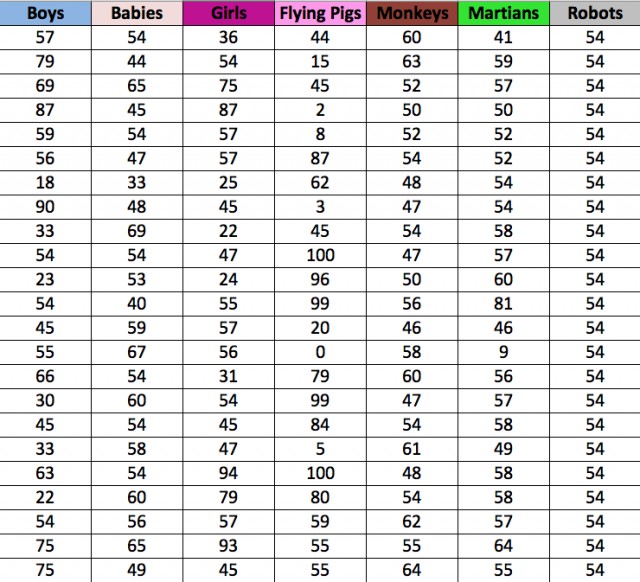Comparing Data Distributions

'Whose results are best? Boys, Girls, Monkeys, Martians, Flying pigs, Babies or Robots?'
All of the above species were asked to take a multiple choice mathematics test and the results were recorded. Now it is up to us to decide how the species compared to each other! This exercise is all about looking at the subtle differences between data sets. What do they have in common? Where are they different? There are lots of answers to both of those questions. There are lots of different ways to approach this task and your teacher will help you decide how. You will need to calculate averages and measures of spread/dispersion. More importantly, you will need to think about what these tell us about the different species and how they can be used to compare them! This can be done on paper, with a calculator or using computers. Which ever way you do it, there are lots of surprises and 'Who is the best?' becomes a very difficult question to answer! Good luck!
Resources
As suggested above, there are a number of ways to approach this task. The resources are below.
The most open approach to this task is to start with just the data and do your own analyses from scratch!
![]() The Data - This is the seven data sets you need to do the analyses.
The Data - This is the seven data sets you need to do the analyses.
Otherwise, or as well, you can do these matching activities to help you unlock the secrets in the data.
![]() Match the box plots and histograms - In this task you must match a box plot and a histogram to each of the data sets.
Match the box plots and histograms - In this task you must match a box plot and a histogram to each of the data sets.
![]() Match the descriptions - In this task, a summary analysis of each species is given and your job is to match it to the correct species.
Match the descriptions - In this task, a summary analysis of each species is given and your job is to match it to the correct species.
Teachers will need to think briefly about how they want to run this activity by reading the Comparing data distributions teacher notes.
The Data
Here is a screen shot of the data you will be working with....

Description
- Students are presented with the data and the idea.
- Teachers decide how they want students to approach the task.
- Students can be presented with the raw data and asked to analyse, present and summarise.
- Students can do the matching exercise with the box plots and histograms.
- Students can do the matching exercise with the descriptions.
- Any of the above work can be put together to make a display.

